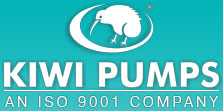
Pumps Information » Diaphragm Pumps
Diaphragm Pumps
Diaphragm Pumps are common industrial pumps that use positive displacement to move liquids. These devices typically include a single diaphragm and chamber, as well as suction and discharge check valves to prevent backflow. Pistons are either coupled to the diaphragm, or used to force hydraulic oil to drive the diaphragm.
Diaphragm pumps are highly reliable because they do not include internal parts that rub against each other. In fact, prolonged diaphragm life may be possible if the diaphragm pump is run dry to prime. Typically, wear on the diaphragm or flap is due to the corrosive properties of media fluids or gases and/or excessive air supply pressures. Diaphragm materials such as ethylene propylene (EPDM), polytetrafluoroethylene (PTFE), plastic, rubber, and elastomers provide resistance to chemicals, sunlight, weathering, and ozone. Housing materials include aluminum, brass or bronze, cast iron, plastic and stainless steel. Rugged diaphragm pump housings can withstand high temperatures and may be exposed to various grades of water, oils, and other solvents.
Diaphragm pumps can handle a range of media that includes abrasive materials, acids, chemicals, concrete or grout, coolants, combustible or corrosive materials, effluents, ground water, and gasoline or diesel fuel. Some diaphragm pumps can handle hazardous materials, highly viscous fluids, liquids with solids, or liquids with oil. Other diaphragm pumps can handle lubricants, oil, potable water, salt water, wastewater, powder or solids, sewage, sludge, and slurry or ash slurry. Important specifications for diaphragm pumps include maximum discharge flow, maximum pressure discharge, inlet size, discharge size, and media temperature. Power sources include AC voltage, DC voltage, pneumatic or hydraulic systems, natural gas, gasoline, steam, water, or solar power. Manually powered diaphragm pumps are devices that are not supplied with a power source are also available.Diaphragm pumps are used in a variety of industries and applications.
Some devices are used in aerospace or defense, agriculture or horticulture, automotive, brewery or distillery, construction, cryogenic, dairy, or flood control applications. Other diaphragm pumps are used in food service, food processing, HVAC, machine tool, maritime, mining, and municipal applications. Diaphragm pumps for oil and gas production include special petrochemical and hydrocarbon devices that can transport large quantities of crude oil, gasoline, kerosene, diesel oil, lubricating oil, paraffin wax, asphalt, chemical raw material, and petroleum solvents. Diaphragm pumps are also used in medical, pharmaceutical, and biotechnology applications; power generation; the pulp and paper industries; and in the production of semiconductors.
